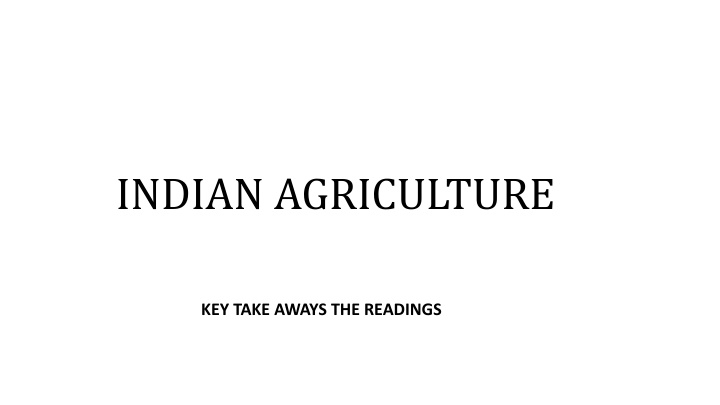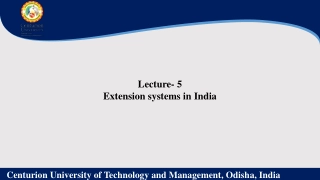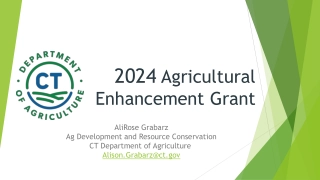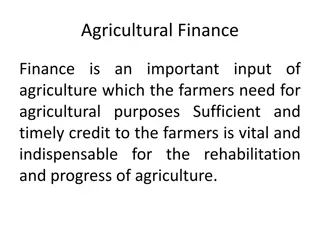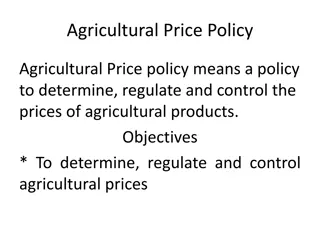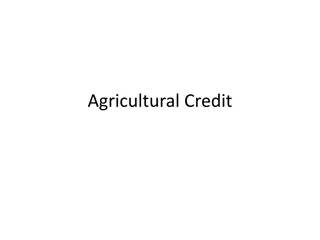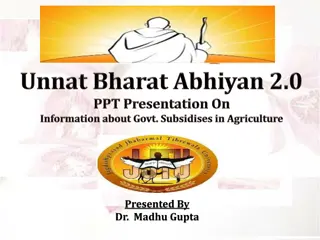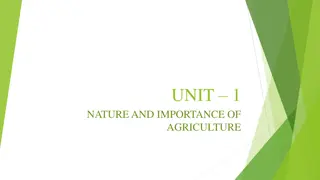Importance of Agricultural Development in India and Its Impact on the Economy
Indian agriculture plays a crucial role in economic growth, employment generation, food security, and sustainability. Three key goals of agricultural development in India focus on growth, inclusiveness, and sustainability. Agriculture contributes significantly to GDP, employment, food security, and poverty reduction. It is essential for achieving Sustainable Development Goals (SDGs) and ensuring inclusive growth sectors in the economy. Structural changes are necessary to enhance productivity and linkages within the sector.
Download Presentation

Please find below an Image/Link to download the presentation.
The content on the website is provided AS IS for your information and personal use only. It may not be sold, licensed, or shared on other websites without obtaining consent from the author.If you encounter any issues during the download, it is possible that the publisher has removed the file from their server.
You are allowed to download the files provided on this website for personal or commercial use, subject to the condition that they are used lawfully. All files are the property of their respective owners.
The content on the website is provided AS IS for your information and personal use only. It may not be sold, licensed, or shared on other websites without obtaining consent from the author.
E N D
Presentation Transcript
INDIAN AGRICULTURE KEY TAKE AWAYS THE READINGS
3 goals of agricultural development in India (a) GROWTH- achieve 4% growth in agriculture and raise incomes, increasing productivity (land, labor, total factor), structural transformation within agriculture and farm to non- farm sector; (b) INCLUSIVENESS - second goal is inclusiveness by focusing on small and marginal farmers, lagging regions, Eastern India, rainfed areas, disadvantaged groups, women, contribution to poverty reduction and food and nutrition security (c) SUSTAINABILITY - third goal is to maintain sustainability of agriculture by focusing on environmental concerns, climate change and resilience
IMPORTANCE OF AGRICULTURE IN THE ECONOMY AND MAJOR AREAS OF CONCERN CONTRIBUTION TO GDP: one-sixth but has the potential of contributing more through forward and backward linkage effects. There are significant linkages between farm and non-farm sectors. The importance of agriculture on non-agricultural sector growth is significant (Johsnston and Mellor,1961 and Mellor,1976). Later, the importance of structure change within agriculture and the role of rural non-farm sector has also been emphasised (Mellor, 1976; Liedholm and Kilby, 1989; Ranis and Stewart, 1993). CONTRIBUTION TO EMPLOYMENT: Agriculture remains an important sector in terms of providing livelihoods, provides employment to 56% of the indian workforce. Although employment elasticity of agriculture declines over time, the absolute size of the rural labour force continues till economies attain higher levels of transformation. Labour productivity in agriculture can be increased with structural change in agriculture, development of rural non-farm sector or migration to urban areas. Many countries fail to manage this transformation at an adequate rate and face political problems with low incomes of the agricultural population (Rosegrant and Hazell, 2000). FOOD SECURITY: Agriculture has significant linkages to food and nutritional security (IFPRI, 2015). This sector also plays an important role in adaptation and mitigation strategies relating to climate change (IPCC, 2001 and 2007). Similarly, agriculture development is crucial for reduction in poverty (World Bank, 2008). Thus, farm sector is also crucial for inclusiveness and sustainability. CONTRIBUTES TO SDGS : At global level, a goal on agriculture is included in Sustainable Development Goals (SDGs). Goal 2 of SDGs includes targets on agricultural productivity and sustainability as agriculture is also critical to achieve many other SDGs relating to hunger, malnutrition, climate change, gender equity, natural resources protection and jobs. There are also initiatives like Compact 2025 which aims to end hunger and under nutrition by 2025. This goal has to be attained five years before targeted achievements of SDGs in 2030. MOST INCLUSIVE GROWTH SECTORS IN THE ECONOMY
PERFORMANCE OF INDIAN AGRICULTURE Agricultural Growth and Structural Change It is known that the decline in the share of agricultural workers in total workers has been slower than the decline in the share of agriculture in the GDP . There is a need for structural change in both output and employment of agriculture. Agricultural GDP refers to agriculture and allied activities. But, if we extend this to throughout the value chains which includes food and agro processing, the share of agriculture GDP will be much higher and has significant linkages with other sectors. In the decade of 1960s, agricultural growth rate was around 1% per annum. In other periods, the growth rates range from 2.2% to 2.7% per annum. The highest growth rate of GDP from agriculture was 3.7% per annum during 2004- 05 to 2013-14. The growth rate in agriculture in the period 2009-10 to 2013-14 was 4.3% per annum. This is one of the highest growth rates recoded in independent India.
PERFORMANCE OF INDIAN AGRICULTURE Performance of Agriculture in the post Independence era has been impressive as compared to the pre-Independence period. Extensive cultivation characterised Indian Agriculture in the pre- and post Green Revolution period. There was a notable increase in- Use of modern inputs net irrigated area Fertilizer consumption area under HYVs In the post Reforms period, in response to growing domestic and export demand for non-cereal food items, there has been a discernible shift in the allocation of resources from cereals to dairy farming, poultry, edible oils, meat, fish etc. These enterprises being labour intensive contributed to wage employment.
POLICIES SINCE INDEPENDENCE INSTITUTIONAL REFORMS (Land Reforms) PUBLIC INVESTMENT POLICIES (massive investment in agriculture) During the first three 5-year plans(1950-65), institutional reforms and public investment policies dominated. INCENTIVE POLICIES (1967-90) / green revolution REFORMS AND GLOBALISATION POLICIES (post 1991)
INSTITUTIONAL REFORMS Land Reform refers to efforts to reform the ownership and regulation of land in India. 2 specific objectives: to remove impediments that arose from the agrarian structure inherited from the past so as to increase in agricultural production to eliminate all elements of exploitation and social injustice within the agrarian system, to provide security for the tiller of the soil and assure equality of status and opportunity to all sections of the rural population. THREE MAIN ASPECTS: Abolition of intermediaries (rent collectors under the pre-Independence land revenue system); Tenancy regulation (to improve the contractual terms including the security of tenure); Ceiling on landholdings (to redistributing surplus land to the landless);
PUBLIC INVESTMENT POLICIES PRIME OBJECTIVE: To achieve self-sufficiency in food grains STEPS: MASSIVE PUBLIC INVESTMENTS IN CONSTRUCTING IRRIGATION RESERVOIRS AND DISTRIBUTION SYSTEMS EXPANSION OF INSTITUTIONAL CREDIT- in order to put an end to the exploitative practices of the informal sources of credit wit respect to exorbitant rate of interest and other terms and conditions
INCENTIVES POLICIES (1967-90) Combination of public investments and adoption of new technology (after the humiliating experience of importing food grains, there was a vigorous drive to achieve self sufficiency in food grains) Incentive Policies Focussed On Both Inputs And Output. INPUT SIDE: Subsidies On Inputs- Irrigation, Credit, Fertilizers And Power Introduction of HYVs Dual goal of protecting farmers interests by providing inputs at lower prices and encourage diffusion of new technology OUTPUT SIDE: Procurement Cum Distribution Policy Support prices at sowing and buy all grains for sale at this price FOOD CORPORATION OF INDIA & AGRICULTURAL PRICES COMMISSION established in mid-1960s
REFORMS AND GLOBALISATION POLICIES Agriculture during this set of policies (not primarily aimed at agriculture) benefitted from reduction to protection to industry. Removing external and domestic controls led to a significant rise in exports of agricultural output. Terms of trade improved in favour of agriculture and also there was an increase in private investments. Addressed the pessimism that existed prior reforms in international trade in agriculture. However on the down side, there was increasing emphasis on price factors of agriculture at the cost of non-price factors like research, technology, irrigation and credit.
POLICY CHANGES NEEDED FOR HIGHER GROWTH PRICE POLICIES Price factor was important even during green revolution time along with technology. We have not been able to provide remunerative prices for farmers in the last 70 years since independence. Farmers have been getting low prices in normal, drought and good years because of distortions in price and market policies. A PRICE STABILSATION MECHANISM NEEDS TO BE WORKED OUT TO PROTECT FARMERS FROM THE VOLATILITY OF PRICES. LAND ISSUES The tenants for the lease period49. It also recommends facilitating all tenants to access bank credit and insurance facilities. re is consensus among majority of agricultural economists that land tenure should be legalised. Small holders will have access to land due to this measure. An expert committee chaired by T.Haque prepared a Model Leasing Act at national level. It recommends legalizing land tenancy to provide complete security of land ownership rights for land owners and security of tenure for
IRRIGATION AND WATER MANAGEMENT Since independence, India invested significantly in irrigation infrastructure particularly canal irrigation. Prime Minister s Krishi Sinchai Yojana (PMKSY) introduced by the present government is in the right direction. However, strategy on irrigation development is preoccupied with increasing water supplies and neglected efficiency of use and sustainability (Vaidyanathan, 2010). Because the government highly subsidizes both canal water rates and the power tariff for drawing groundwater, much of this water is unfortunately either used inefficiently or overused. Areas of reforms needed in irrigation are: stepping up and prioritizing public investment, raising profitability of groundwater exploitation and augmenting ground water resources, rational pricing of irrigation water and electricity involvement of user farmers in the management of irrigation systems and, making groundwater markets equitable (Rao, 2005). SUBSIDIES AND INVESTMENT
RESEARCH AND EXTENSION Yields for several crops in India are lower than many countries of the world. Similarly, growth in total factor productivity in India has been lower compared to countries like Brazil, China and Indonesia (BIC)50. What policies, investment and institutions explain these differences? There is no single bullet for lower productivity in India. Overall these three BIC countries invested more in technology, extension, education, transport, energy and better institutions (Lele et al, 2018). India is trailing and should invest more in each of these areas and implement effectively. DOMESTIC MARKET FORMS In developing countries like India, we have missing middle in marketing. Value chain runs from production to processing. For example, storage, processing and agri-business are missing. As mentioned above, India processes very limited quantities of fruits and vegetales. Post-harvest losses are also high. In order to link farmers to retailers and processing, we need investments and increase efficiency. CREDIT: the Government has to be sensitive to the three distributional aspects of agricultural credit. These are: not much improvement in the share of small and marginal farmers; increase in the share of indirect credit in total agricultural credit and; significant regional inequalities in credit. Indebtedness of marginal and small farmers is another issue to be tackled.
POLICY SUGGESTIONS (1) There is a need for change in the narrative in the new context; (2) Global trends and macro policies are equally important for Indian agriculture (3) We have to walk on two legs both agriculture and non-agriculture. There is a need to shift from cereal based agriculture to non-cereal based crops and allied activities; (4) Doubling farm income also has to focus non-farm sector, look at different size classes and environmental considerations; (5) Remunerative prices and market reforms can enhances farmers' incomes; (6) The country has to go beyond harvest and give freedom for farmers on markets and exports; (7) Do not forget basics like water and technology; (8) Inclusiveness is needed for board based growth and equity. Focus on small and maginal farmers, women, youth, rainfed areas, Eastern and other lagging regions, social groups like SC and ST farmers; (9) Measures have to be taken to take care of impacTs of climate change and improving resilience in agriculture and sustainability; (10) Strengthening institutions and governance is crucial for achieving growth, equality and sustainability of agriculture
